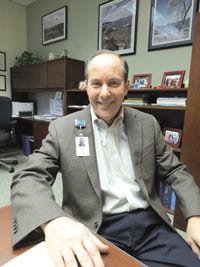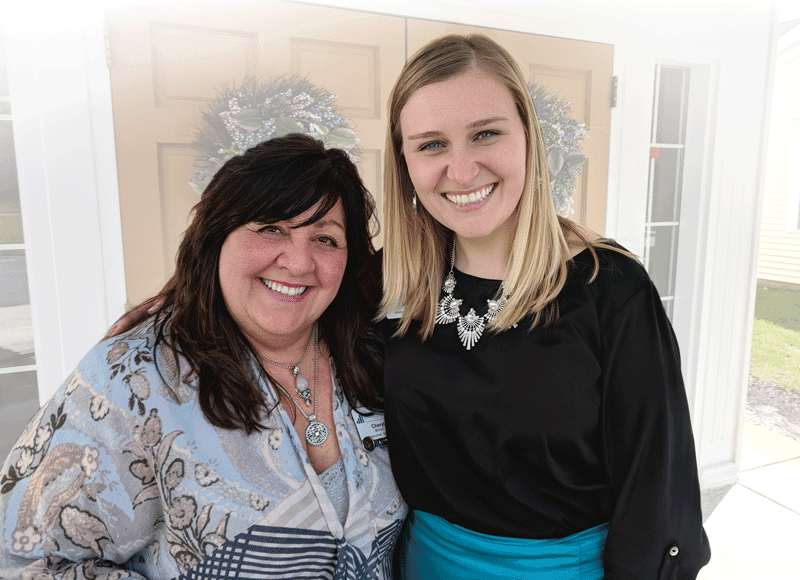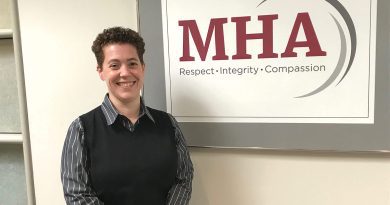Succession Planning – Keroack Prepares to Take the Reins at Baystate Health
Dr. Mark Keroack remembers thinking that Victor Woolridge, chairman of the Baystate Health board of directors, probably just wanted to get to know him and see how he was faring in his relatively new role as executive vice president and chief operating officer of the system.
But this invitation to dinner late last spring had a much different purpose, as he would soon find out.
Indeed, Woolridge would soon inform Keroack that Mark Tolosky, long-time president and CEO of the system, would be stepping down in about a year, and there was strong sentiment among administrators and board members that he would be the right person to step in and succeed him.
“I was flabbergasted,” Keroack recalled, adding that there was a brief “oh my God” moment — “can I do this?” — followed quickly by thoughts about how, not if, if he could handle this assignment.
And he didn’t have far to look for both inspiration and advice. His wife, Anne, also a physician (a cardiologist), is president and CEO of St. Peter’s Hospital and Albany Memorial Hospital, two components of St. Peter’s Health Partners, a system in the Albany, N.Y. area that is roughly the same size as Baystate.
“I had gotten a sense of the demands of the job from her,” said Keroack, adding that, by the time the formal announcement that he would succeed Tolosky was made in late November, after months of intense vetting, he was getting increasingly comfortable with the scope — and the specifics — of the task of managing the region’s largest health system and one of the largest in the Commonwealth.
“I’m excited about the opportunities and challenges ahead,” said Keroack, whose 34-year career in healthcare has included everything from treatment of AIDS patients in the mid-’80s to pioneering work in the broad realms of quality and accountability to efforts to negotiate the merger of Memorial Health Care and UMass Medical Center in the late ’90s. And he intends to take experiences, and lessons, from each stop to the role he will assume later this year, especially the “puzzle-solving” mentality that he believes characterizes those, like himself, who become infectious-disease specialists.
When Keroack does take the helm, he will become part of what many see as an emerging trend in healthcare — placing individuals trained as medical doctors at the helm of large healthcare systems.
Keroack said he doesn’t know how prevalent this movement, if it can be called that, has become, but described it as a “growing phenomenon,” and a first for Baystate, at least in the past century.
Keroack, who still has a white coat in his office but has made a conscious decision not to wear it (more on why later), drew an analogy to the difference between playing and coaching a sport as he talked about the shift from practicing medicine to being a hospital or health-system administrator. He noted that, while they are somewhat different, there are certainly rewards in each realm.
“In a clinical role, you’re focused like a laser beam on the patient in front of you in that moment — are you doing everything right to help them get better, etc., etc.,” he explained. “As a group, physicians are beginning to understand that we also need to think about how we design the systems that take care of patients. Do we have a fail-safe system to make sure that patients get all their medicines on time? Physicians have a role in that, and I think that a modern understanding of what it means to be a doctor includes that.
“In the world I grew up in, it was one doctor, one patient, and I think physicians of my generation are naturally suspicious of large organizations as being out of touch with what’s important in healthcare,” he went on. “But as I sort of merged into the role, and particularly in the 1990s, when I started designing things around a capitated healthcare model, I realized that, if you set up certain systems, you could really make an impact on people’s lives.”
When asked to write a quick job description for the role he will assume, he went on for some time, but summed it up neatly by saying, “I’m trying to paint the picture of where we’re going in healthcare, and to encourage people to do creative things.
“In leading a cultural change, you need to be able to chart a vision,” he went on, adding quickly, “all of this stuff has nothing to do with anything I learned in medical school — I’ve had to make a study of management and leadership to be successful in this job.”
For this issue, HCN talked at length with Keroack about his broad-ranging career in healthcare, and about what will be the next top line on his lengthy résumé.
On the Road
To say that Keroack has healthcare in his blood would be quite an understatement.
His father was a physician and his mother a nurse. He is one of six children, five of whom went on to become physicians.
Born in New Hampshire, he was 2 when his family relocated to Springfield. His father opened up a practice in the family home on Wilbraham Road, and some of Keroack’s earliest memories are of people coming to the house at all hours of the day and night and his father leaving on frequent house calls. The elder Keroack would later become part of one of the first full-time emergency-medicine groups at what was then Wesson Memorial Hospital before it merged with Springfield Hospital, creating Baystate Medical Center.
Keroack attended Amherst College, where he focused on the sciences, and then Harvard Medical School. One of the highlights of that experience was being one of the first American medical students to study and work at the Albert Schweitzer Hospital in the West African nation of Gabon.
There, he worked in what he called tropical medicine, and subsequently “fell in love” with the specialty of infectious diseases.
“This was an interesting turning point in my life,” he told HCN. “The infectious-disease doctors were the great puzzle-solvers of medicine. They were some of the smartest people in the hospital; patients would have these mysterious illnesses, and they would call in the infectious-disease guys, and they would figure that they had some unusual infection or some unusual disease that caused a fever, and it was no infection at all.
“I just thought they were fabulous, talented people who could do a little bit of everything,” he went on, “and I wanted to be one of them.”
Keroack would later train at Brigham & Women’s Hospital in Boston under Dr. Louis Weinstein — considered one of the founders of the modern specialty of infectious diseases, and one of the first to use penicillin — who became Keroack’s mentor.
“I came out thinking I was going to be one of these puzzle-solver doctors, but just as I came out of training, the AIDS epidemic broke,” he said. “I became very involved with treating AIDS patients, and obviously there were no puzzles about what was wrong with them; they were infected with a nearly universally fatal disease.
“Those were very difficult years,” he went on. “We were dealing with mostly young men who were sick and at least initially had a very high death rate; it wasn’t until the early ’90s that we had effective medicines that could slow down the whole business.”
Keroack spent more than three years as chief of the Infectious Disease Division at the Brockton/West Roxbury VA Medical Center, and later held the same post for seven years at Memorial Health Care in Worcester. While treating those infected with AIDS, he became active in community-based education programs and social advocacy groups. He was, for example, vice president of AIDS Project Worcester, which ran food banks, buddy programs, clean-needle initiatives, and other endeavors.
“It was a very unexpected turn in my career,” he explained. “I thought I was going to be this high-powered, intellectual diagnostician, but I really started practicing palliative care before it had a name. We were talking about keeping people comfortable and making sure they knew what was wrong, and that sort of thing.”
There would be more turns to come, career-wise, he went on, adding that, by the mid-’90s, AIDS was a treatable disease, and he was starting to become interested in another, still-emerging realm in healthcare — a focus on quality, safety, and clinical-outcomes measurement, which came as healthcare was experiencing its first movement into capitated care and away from the fee-for-service model.
He would go on to serve as director of Clinical Process Improvement and then vice president of Medical Management at Memorial, which merged with UMass Medical Center in 1998 to become UMass Memorial Health Care. He would later serve as the first executive director of the 700-physician UMass Memorial Medical Group.
“I designed measurement systems and clinical-practice guidelines, and got doctors to work in groups and teams to improve measurable outcomes of care,” he said. “It was thought to be fairly radical activity at the time; people didn’t feel that healthcare could be legitimately measured, but it’s considered commonplace now.”
By the late ’90s, Keroack had all but put aside the white coat as he continued and accelerated a career shift into management. In 2000, he joined the University Health System Consortium, where he eventually rose to the rank of senior vice president and chief medical officer, overseeing programs for clinical and operational process improvement, faculty-group-practice management, patient safety, and accreditation.
In 2011, he returned to Springfield, taking a position as president of Baystate Medical Practices, and in 2013, he was promoted to executive vice president and COO.
He was only in that role a few months when Woolridge called and invited him to dinner.
Setting a Course
When asked about what attracted him to Baystate, Keroack said it was both the system’s reputation for quality and its apparent willingness to “have a go,” as he put it, at population-based health care, with a model in many ways similar to what he was trying to implement in Worcester more than 15 years ago.
“Except now, there are better tools, there’s better information, and a better understanding of how to do it; it was just a question of connecting the dots and making all the pieces work together,” he said, adding that he’s excited about the prospect of leading this initiative as CEO, rather than as president of Baystate Medical Practices, which, he told HCN, was a post he took thinking it would be the last line on his résumé.
When Greg Harb, then-executive vice president and COO, left his position in April, Keroack was chosen to succeed him. A few months later, the process of selecting a successor to Tolosky accelerated in earnest, and Keroack was the subject of a lengthy — and intense — vetting process, which he passed.
And thus, he returns to the subject of the physician as hospital or health-system CEO. Keroack said this is now the rule, rather than the exception, in the Bay State, where almost every hospital with more than 300 beds has an M.D. at the helm.
When asked to identify the advantages that might come to those administrators who are also medical doctors, Keroack said there are several, and they mostly involve having a direct understanding of the work physicians do and the challenges they face, which can certainly be a help as a system tackles the ongoing assignment of undertaking, and facilitating, change.
“It gives you some advantages as you ask people to do things differently,” he explained. “Rather than take a physician’s assertion at face value that ‘we can’t do it that way,’ or ‘it can’t be done,’ you can challenge people in a way that’s more authentic and credible, and make change happen more quickly.
“And particularly at a time when the whole financing of healthcare is being redefined and is under pressure, there are a lot of physicians who are feeling that it’s all about money now,” he went on. “It’s important for the leadership of the organization to project a value system that’s focused on patients, rather than focused on profits, and quite frankly, I don’t find that hard to do at all, because that’s the core value system I brought to my career from day one.”
Looking ahead, he said he expects the transition in leadership to be a smooth one, although there is considerable work to do in the coming months.
There is the matter of integrating Wing Memorial Hospital into the Baystate system — the intention to assume ownership from UMass Memorial was announced last month, and the deal is expected to be finalized in the next few months — as well as simply getting acquainted with a number of constituencies, from the system’s board to the business community to area legislative leaders.
He calls it “getting more externally focused.”
“There are a lot of people I have to get to know,” he explained. “It’s much more of an external job than the one I’ve been doing.”
But there is work internally as well, especially the task of assimilating what will be a mostly new senior leadership team, or ‘president’s cabinet.’
It will include a new president of Health New England — Maura McCaffrey will succeed Peter Straley later this year — a new president of Baystate Health Practices, Dr. John Schriber, who will start later this month, and a new chief strategy officer, Jennifer Endicot.
“There will be a number of newbies on that senior leadership team,” he said, adding that he was glad Tolosky committed to staying on another year after his retirement in the role of president emeritus, and that there will be a long lead-up time to his official start date in the corner office.
“I would guess this is probably as orderly a ramp-up for a new hospital or health system CEO as any that I’ve seen,” he told HCN.
Hire Ground
Keroack said he doesn’t wear his white coat anymore because he doesn’t want to be disrespectful to those who don them every day, often for quite lengthy shifts.
“I don’t want to fool anyone into thinking that I can put a white coat on and become a doctor — it’s much more complex than that,” he explained. “I have too much respect for the clinician to pretend I’m one of them; I wish I could be, but it would be too demanding to keep my skills up.
“But I do understand their world,” he added quickly, noting that this understanding might have helped him navigate that vetting process he went through last summer and fall, and it will likely be a huge asset in what will be yet another intriguing — and challenging — career turn.




